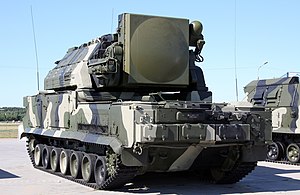| 9K330 Tor NATO reporting name: SA-15 Gauntlet, SA-N-9 Gauntlet | |
|---|---|
 9K330 TLAR (rear view of the chassis) | |
| Type | Tracked SAM system |
| Place of origin | Soviet Union/Russia |
| Service history | |
| In service | 1986–present |
| Used by | See list of operators |
| Production history | |
| Designer | Almaz-Antey:
|
| Designed | 1975 |
| Manufacturer |
|
| Produced | 1983–present |
| Variants | Tor, Tor-M1, Tor-M2, Tor-M1-2U |
| Specifications (Tor-M1) | |
| Mass | 34 tonnes (33 long tons; 37 short tons) |
| Length | 7,500 millimetres (300 in) |
| Width | 3,300 millimetres (130 in) |
| Height | 5,100 millimetres (200 in) (radar mast unstowed) |
| Crew | 3 |
Main armament | 9M330, 9M331 |
| Engine | V-12 diesel 618 kilowatts (829 hp) |
| Transmission | hydromechanical |
| Suspension | torsion bar |
| Ground clearance | 450 millimetres (18 in) |
Operational range | 25 kilometres (16 mi)[1] |
| Maximum speed | 65 kilometres per hour (40 mph) |
The Tor (Russian: Тор; English: torus[2]) is an all-weather, low-to medium-altitude, short-range surface-to-air missile system designed for destroying airplanes, helicopters, cruise missiles, unmanned aerial vehicles and short-range ballistic threats (anti-munitions). Originally developed by the Soviet Union under the GRAU designation 9K330 Tor, the system is commonly known by its NATO reporting name, SA-15 "Gauntlet". A navalized variant was developed under the name 3K95 "Kinzhal", also known as the SA-N-9 "Gauntlet". Tor was designed to shoot down guided weapons like the AGM-86 ALCM and BGM-34[3] day and night, in bad weather and jamming situations.[4] Tor can detect targets while on the move. The vehicle must stop intermittently when firing,[5][6] although trials have been conducted with the goal of eliminating this restriction.[7]
- ^ "TOR M1 - Hellenic Air Force". Haf.gr. Retrieved 15 March 2022.
- ^ "Бублик" остроконечный (in Russian). RIA Novosti. 15 December 2005. Archived from the original on 7 October 2008. Retrieved 4 September 2008.
- ^ Cite error: The named reference
PVOwas invoked but never defined (see the help page). - ^ "Российские зенитные ракетные комплексы "Тор" на международной авиационно- космической выставке "Аэрошоу Чайна – 2014"". dokwar.ru. Archived from the original on 29 March 2018. Retrieved 30 April 2018.
- ^ "На вооружение войск ЮВО поступили новые ЗРС "Тор-М1-2У"". aftershock.su. Archived from the original on 6 November 2014. Retrieved 14 November 2014.
- ^ "Техника ПВО". russianguns.chat.ru/pvo.htm. Archived from the original on 1 October 2015. Retrieved 14 November 2014.
- ^ "Tor-M2U po raz pierwszy strzelał w marszu". konflikty.pl. 30 September 2015. Archived from the original on 1 October 2015. Retrieved 30 September 2015.